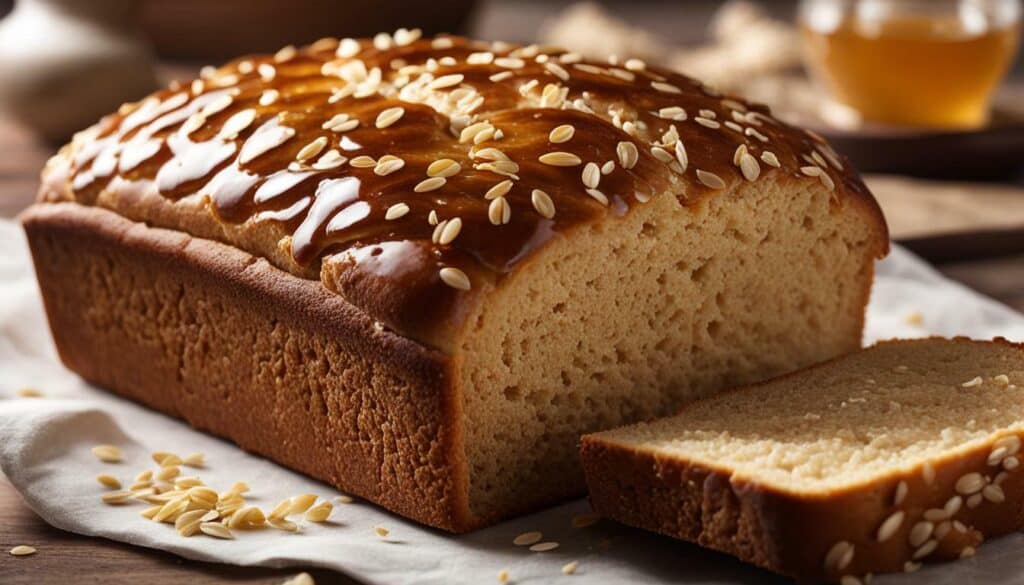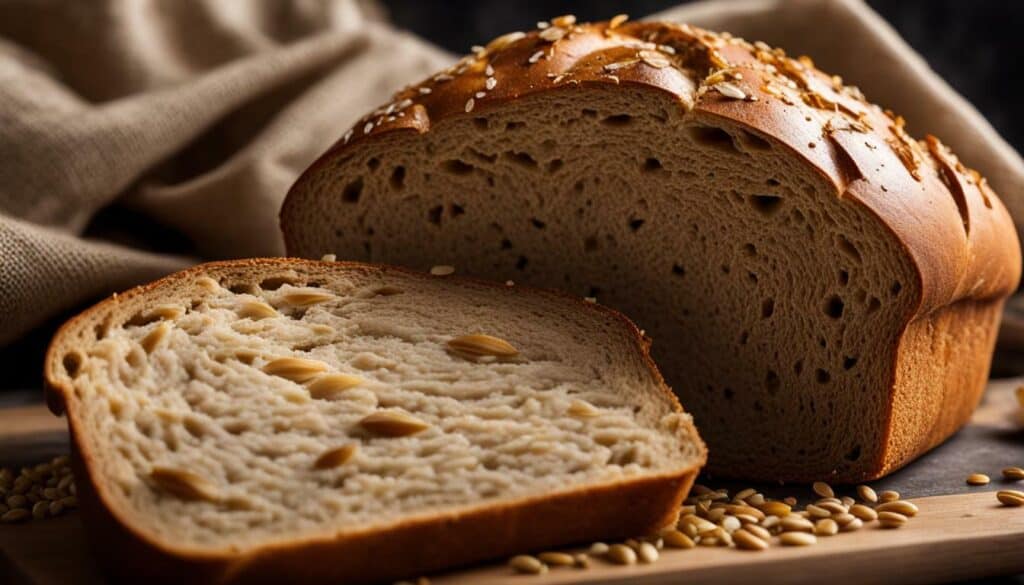If you’ve ever wondered about the calorie content of a bread bowl, you’re in the right place. In this section, I will uncover the truth about the calories in a bread bowl, providing you with the essential information you need to make informed choices about your meals.
When it comes to indulging in a bread bowl, it’s important to understand its nutritional value. This knowledge can help you maintain a balanced diet while still enjoying this savory treat.
Key Takeaways:
- Calories in bread bowls can vary depending on the specific ingredients and fillings.
- Panera’s Mac and Cheese bread bowl contains 470 calories, 30g of fat, 36g of carbs, 17g of protein, and 1g of sodium in a small serving.
- Panera’s Mac and Cheese bread bowl is not considered a healthy option due to its high calorie, fat, and carbohydrate content.
- Honey oat bread, commonly used for bread bowls, is typically a combination of various flours, including whole wheat flour, all-purpose flour, and rolled oats.
- Whole wheat bread is a more nutritious choice, as it is rich in dietary fiber, vitamins, minerals, and antioxidants.
The Calorie Count of Panera’s Mac and Cheese Bread Bowl
Panera’s Mac and Cheese bread bowl is a crowd favorite, but how many calories does it actually pack? Let’s dive into the nutritional information to find out!
In a small serving of Panera’s Mac and Cheese bread bowl, you can expect to consume approximately 470 calories. With 30g of fat, 36g of carbs, 17g of protein, and 1g of sodium, it’s important to be mindful of your overall dietary intake.
While Panera’s Mac and Cheese bread bowl may be a delicious indulgence, it’s worth noting that it is not considered a healthy option due to its high calorie, fat, and carbohydrate content. However, compared to other meals, it does contain a relatively low amount of sugar, with only 9g per serving.
For those looking for a more nutritious alternative, whole wheat bread can be a great choice. Rich in dietary fiber, vitamins, minerals, and antioxidants, whole wheat bread provides a host of health benefits. On the other hand, honey oat bread, commonly used for bread bowls, is not entirely whole wheat and often combines various flours.
| Nutrient | Amount per serving |
|---|---|
| Calories | 470 |
| Fat | 30g |
| Carbohydrates | 36g |
| Protein | 17g |
| Sodium | 1g |

When it comes to bread bowls, the type of bread used plays a significant role in the overall nutritional value. Honey oat bread, commonly used, typically includes a blend of whole wheat flour, all-purpose flour, rolled oats, honey, yeast, water, and salt as key ingredients. This combination provides a unique texture and flavor.
However, it’s important to note that honey oat bread is not entirely whole wheat, as it incorporates additional flours. To ensure you’re making informed choices, pay attention to the ingredients and consider whole wheat bread if you’re looking for a more health-conscious option.
Is Panera’s Mac and Cheese Bread Bowl a Healthy Option?
As tempting as it may be to indulge in Panera’s Mac and Cheese bread bowl, let’s find out if it aligns with your health goals. To make an informed decision, we need to understand the nutritional information of this savory dish.
One small serving of Panera’s Mac and Cheese bread bowl contains approximately 470 calories, 30g of fat, 36g of carbohydrates, 17g of protein, and 1g of sodium. While it may satisfy your cravings for comfort food, it’s important to note that these numbers contribute significantly to your daily calorie and fat intake. Therefore, it may not be the best choice if you’re watching your weight or following a low-fat diet.
Moreover, the high carbohydrate content can cause a spike in blood sugar levels, making it less suitable for individuals with diabetes or those aiming to control their blood sugar. Additionally, Panera’s Mac and Cheese bread bowl falls short in terms of offering a balanced meal, lacking ample vegetables and whole grains.
To provide a healthier alternative, consider opting for a salad or a sandwich on whole wheat bread instead. Whole wheat bread offers a range of nutritional benefits, including dietary fiber, vitamins, minerals, and antioxidants. By choosing whole wheat bread, you can enjoy the goodness of complex carbohydrates while promoting better digestion and long-lasting energy.
The Benefits of Whole Wheat Bread:
- Rich in dietary fiber, aiding in digestion and promoting satiety
- Contains vitamins and minerals essential for overall health
- Offers antioxidants that protect against cellular damage
- May lower the risk of heart disease and certain types of cancer
When it comes to selecting the bread for your bread bowl, it’s important to consider the ingredients and nutritional value. Honey oat bread, typically used for bread bowls, is not entirely whole wheat. It often incorporates a combination of various flours, including whole wheat flour, all-purpose flour, rolled oats, honey, yeast, water, and salt. While it may offer a slightly sweeter taste profile, it still provides a decent amount of dietary fiber and nutrients.
| Bread: | Calories per Serving | Fat per Serving | Carbohydrates per Serving | Protein per Serving | Sodium per Serving |
|---|---|---|---|---|---|
| Panera’s Mac and Cheese Bread Bowl | 470 | 30g | 36g | 17g | 1g |
| Honey Oat Bread | Varies | Varies | Varies | Varies | Varies |
| Whole Wheat Bread | Varies | Varies | Varies | Varies | Varies |

In conclusion, when it comes to the healthiness of bread bowls, Panera’s Mac and Cheese option falls short with its high calorie, fat, and carbohydrate content. Opting for whole wheat bread or honey oat bread can offer a better balance of nutrients. Remember to consider your health goals and dietary requirements when indulging in these delightful bread bowls.
Understanding the Composition of Honey Oat Bread
Honey oat bread provides the base for many delicious bread bowls, but what exactly is it made of? This type of bread typically incorporates a combination of whole wheat flour, all-purpose flour, rolled oats, honey, yeast, water, and salt as key ingredients. The result is a bread with a slightly sweet taste and a hearty texture.
The use of whole wheat flour ensures that honey oat bread retains its nutritional value. Whole wheat flour is rich in dietary fiber, which aids in digestion and helps to maintain a healthy weight. It also contains essential vitamins and minerals, including B vitamins, iron, and magnesium, which are important for overall well-being.
In addition to whole wheat flour, honey oat bread includes rolled oats, which contribute to its distinctive texture. Rolled oats are a good source of fiber and offer a range of health benefits, such as reducing cholesterol levels and promoting heart health.
To make honey oat bread, the ingredients are combined, kneaded, and allowed to rise before being baked to golden perfection. The resulting loaf is not only delicious but also provides a wholesome base for bread bowls, adding a touch of sweetness and a satisfying crunch.
Composition of Honey Oat Bread
| Key Ingredients | Quantity |
|---|---|
| Whole wheat flour | 2 cups |
| All-purpose flour | 1 cup |
| Rolled oats | 1/2 cup |
| Honey | 2 tablespoons |
| Yeast | 2 teaspoons |
| Water | 1 1/4 cups |
| Salt | 1 teaspoon |
With its unique blend of ingredients, honey oat bread offers a flavorful and nutritious base for bread bowls. Whether you’re enjoying a warm bowl of soup or indulging in a savory mac and cheese bread bowl, this wholesome bread adds a delightful element to your meal.

Consider swapping out your regular bread for whole wheat to enjoy a range of health benefits. Whole wheat bread is a nutritious choice that is rich in dietary fiber, vitamins, minerals, and antioxidants. Unlike refined white bread, which undergoes a process that removes the bran and germ, whole wheat bread contains all parts of the grain, making it a more wholesome option.
One of the key advantages of whole wheat bread is its high fiber content. Fiber plays a crucial role in digestion, promoting regular bowel movements and preventing constipation. It also helps to control blood sugar levels, making it a suitable choice for individuals with diabetes or those aiming to manage their blood glucose levels.
Moreover, whole wheat bread is a great source of essential vitamins and minerals. It contains B vitamins, such as thiamin, niacin, and folate, which are important for energy production and maintaining a healthy nervous system. Additionally, whole wheat bread is rich in minerals like iron, magnesium, and selenium, which play vital roles in various bodily functions, including red blood cell production and immune system support.
| Nutrient | Amount per 100g |
|---|---|
| Calories | 247 |
| Protein | 10.9g |
| Fat | 2.2g |
| Carbohydrates | 46.0g |
| Fiber | 5.5g |
| Calcium | 34mg |
| Iron | 2.5mg |
By incorporating whole wheat bread into your diet, you can enjoy the benefits of improved digestive health, enhanced nutrient intake, and better overall well-being. So, go ahead and make the switch to whole wheat bread for a healthier and tastier alternative!

If you’ve noticed a slightly bitter taste in your whole wheat bread, there’s a scientific reason behind it. The bran, which is the outer layer of the wheat kernel, contains natural compounds called tannins and phytic acid. These compounds contribute to the bitterness that some people experience when consuming whole wheat bread.
Although the bitterness may be off-putting to some, it’s important to note that tannins and phytic acid actually have health benefits. Tannins are known for their antioxidant properties, which can help protect the body against cell damage caused by harmful molecules called free radicals. Phytic acid, on the other hand, acts as an antioxidant and may have potential benefits in reducing the risk of certain chronic diseases.
While tannins and phytic acid offer health benefits, they can also interfere with the absorption of minerals in the body, such as iron and zinc. This is why it’s recommended to consume whole wheat bread alongside foods rich in vitamin C, as it enhances the absorption of these minerals. Additionally, the bitterness in whole wheat bread can vary depending on factors such as the variety of wheat used and the degree of processing.
Overall, the slightly bitter taste in whole wheat bread is a natural characteristic that comes from compounds like tannins and phytic acid in the bran. While some may find it unpleasant, it’s important to consider the potential health benefits associated with these compounds. Pairing whole wheat bread with vitamin C-rich foods can help maximize the absorption of important minerals.
| Bread Type | Calories per Serving | Total Fat | Carbohydrates | Protein | Sodium |
|---|---|---|---|---|---|
| Panera Mac and Cheese Bread Bowl (small serving) | 470 | 30g | 36g | 17g | 1g |
As you explore the nutritional information of bread bowls, it’s important to consider the impact of whole grain options like whole wheat bread. Its slightly bitter taste, attributed to natural compounds such as tannins and phytic acid, comes with potential health benefits. Pair your whole wheat bread with vitamin C-rich foods for maximum mineral absorption, and enjoy the nutritional goodness it has to offer.

Let’s take a closer look at the science behind tannins and phytic acid and how they contribute to the nutritional profile of whole wheat bread. Tannins are naturally occurring compounds found in plant foods, including whole wheat grains. They are responsible for the astringent, bitter taste often associated with certain foods like tea, wine, and some fruits. In whole wheat bread, tannins are primarily present in the bran layer, which is the outermost part of the grain.
Phytic acid, also known as phytate, is another compound found in plant-based foods, particularly in the bran and germ of whole grains. It acts as a storage form of phosphorus in plants. Phytic acid has been a subject of discussion due to its potential to inhibit the absorption of certain minerals like zinc, iron, and calcium. However, it is important to note that the impact of phytic acid on mineral absorption can vary depending on factors such as the overall diet and individual nutrient needs.

When it comes to whole wheat bread, the presence of tannins and phytic acid contributes to its nutritional profile. While tannins contribute to a slightly bitter taste, they also possess antioxidant properties. Antioxidants help protect the body’s cells from damage caused by harmful molecules called free radicals. Phytic acid, on the other hand, may have potential health benefits, such as reducing the risk of certain types of cancer and kidney stone formation.
In summary, the science behind tannins and phytic acid in whole wheat bread adds to its nutritional value. While tannins contribute to the bitter taste, they also provide antioxidants, and phytic acid may have various health benefits. So, the next time you enjoy a bread bowl made with whole wheat bread, remember the role these compounds play in enhancing both flavor and potential health benefits.
Exploring the Factual Data: Panera Mac and Cheese Nutrition
To get a complete understanding of the calorie content in a bread bowl, it’s essential to examine the specific nutritional information of Panera’s popular Mac and Cheese. This creamy and indulgent dish is a favorite among many, but it’s important to be aware of its nutritional impact.
In a small serving of Panera Mac and Cheese, you can expect to consume approximately 470 calories. This rich and flavorful meal also contains 30g of fat, 36g of carbs, 17g of protein, and 1g of sodium. While the protein content may seem decent, it’s important to note that the calorie, fat, and carbohydrate content of this dish is relatively high.
One aspect worth highlighting is the sugar content of Panera Mac and Cheese. With just 9g of sugar per serving, this dish is relatively low in sugar compared to other meals. However, it’s essential to consider the overall nutritional composition when evaluating its impact on your diet.
Here is a breakdown of the nutritional information in Panera Mac and Cheese:
| Nutrient | Amount per Serving |
|---|---|
| Calories | 470 |
| Fat | 30g |
| Carbohydrates | 36g |
| Protein | 17g |
| Sodium | 1g |
| Sugar | 9g |
While Panera Mac and Cheese may be a tempting option, it’s important to consider it as an indulgence rather than a regular part of a balanced diet. The high calorie, fat, and carbohydrate content can make it challenging to fit into a calorie-controlled eating plan.

“To maintain a healthy lifestyle, it’s crucial to be mindful of the nutritional value of the food we consume.” – Nutritionist Karen Smith
Understanding the nutritional information of Panera Mac and Cheese allows us to make informed choices when it comes to our dietary habits. It’s recommended to enjoy this dish in moderation and balance it with nutritious options to ensure a well-rounded diet.
Conclusion
Understanding the calorie content of a bread bowl can empower you to make mindful decisions while enjoying this delicious dish. By delving into the nutritional information of bread bowls, we’ve gained valuable insights into the calories, fat, carbohydrates, and protein they contain.
Specifically, Panera’s Mac and Cheese bread bowl offers a delectable option with its rich and creamy mac and cheese. However, it’s important to note that this indulgent choice comes with a higher calorie count compared to other meals. With 470 calories, 30g of fat, and 36g of carbs in a small serving, it’s not considered the healthiest option.
On the other hand, exploring the composition of honey oat bread and whole wheat bread has shown us that there are alternatives to consider. Honey oat bread combines various flours, including whole wheat, all-purpose, and rolled oats, resulting in a flavorful and slightly sweet option. Meanwhile, whole wheat bread stands out as a nutritious choice, packed with dietary fiber, vitamins, minerals, and antioxidants.
It’s worth noting that the bitter taste sometimes associated with whole wheat bread can be attributed to natural compounds like tannins and phytic acid in the bran. These compounds have their own health benefits, serving as antioxidants and potentially impacting mineral absorption. So, while the bitterness may be present, it doesn’t detract from the overall nutritional value of whole wheat bread.
Armed with this knowledge, you can now approach bread bowls with increased awareness. Whether you choose to indulge in a creamy mac and cheese bread bowl or opt for a healthier whole wheat variation, knowing the calorie content enables you to make informed choices. So go ahead, savor the flavors, and enjoy your bread bowl in a way that aligns with your dietary goals.
FAQ
Q: How many calories are in Panera’s Mac and Cheese bread bowl?
A: Panera’s Mac and Cheese bread bowl contains 470 calories.
Q: What are the nutritional contents of Panera’s Mac and Cheese bread bowl?
A: In a small serving, Panera’s Mac and Cheese bread bowl contains 30g of fat, 36g of carbs, 17g of protein, and 1g of sodium.
Q: Is Panera’s Mac and Cheese bread bowl a healthy option?
A: No, Panera’s Mac and Cheese bread bowl is not considered a healthy choice due to its high calorie, fat, and carbohydrate content.
Q: What is honey oat bread made of?
A: Honey oat bread typically incorporates a combination of various flours such as whole wheat flour, all-purpose flour, rolled oats, honey, yeast, water, and salt.
Q: What are the benefits of whole wheat bread?
A: Whole wheat bread is a nutritious choice that is rich in dietary fiber, vitamins, minerals, and antioxidants.
Q: Why does whole wheat bread sometimes taste bitter?
A: The bitter taste in whole wheat bread can be attributed to natural compounds like tannins and phytic acid in the bran.
Q: What are tannins and phytic acid?
A: Tannins and phytic acid are natural compounds present in whole wheat bread. They have health benefits, such as being antioxidants, but can contribute to bitterness and prevent mineral absorption.
Q: What is the nutritional content of Panera’s Mac and Cheese?
A: Panera’s Mac and Cheese contains 9g of sugar per serving, 470 calories, 30g of fat, 36g of carbs, 17g of protein, and 1g of sodium in a small serving.
Q: Where can I find a bread bowl calorie calculator?
A: You can find a bread bowl calorie calculator online or through various health and fitness apps.
How Many Calories Does Potato Bread Have Compared to a Bread Bowl?
Potato bread calorie breakdown reveals that this type of bread typically contains around 170 calories per slice. In comparison, a bread bowl, commonly used for serving soups or stews, can have around 200-250 calories per serving. While potato bread is a tasty choice for sandwiches, it may be a slightly lighter option when considering calorie content.
How Many Calories Does a Large Biscuit Have Compared to a Bread Bowl?
When comparing the calories in large biscuit to a bread bowl, there is a significant difference. A typical large biscuit contains around 300-400 calories, while a bread bowl can go as high as 900 calories. It’s essential to be mindful of portion sizes and ingredients to make healthier choices.





Leave a Reply